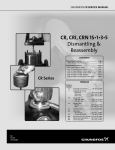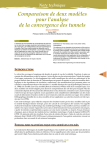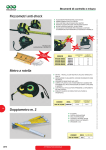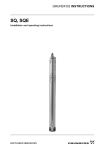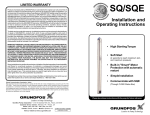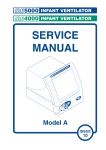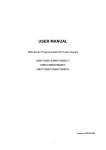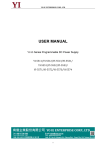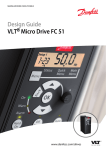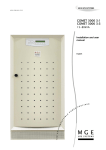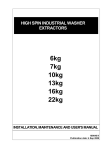Download Service instructions, SQ(E) model B and MS(E) 3 model A
Transcript
Service instructions SQ, SQE, SQ-N Model B MS 3, MSE 3 Model B 50/60 Hz 1~ Table of contents 1. Type identification ........................................................................................................................... 2 1.1 Nameplates........................................................................................................................................ 2 1.2 Type keys .......................................................................................................................................... 5 2. Torques and lubricants ................................................................................................................... 6 3. Service tools .................................................................................................................................... 7 3.1 Special tools ...................................................................................................................................... 7 3.2 Standard tools.................................................................................................................................... 7 3.3 Torque tools....................................................................................................................................... 7 4. Dismantling and assembly ............................................................................................................. 8 4.1 General .............................................................................................................................................. 8 4.2 Separating and connecting pump and motor..................................................................................... 9 4.3 Replacement of hydraulic parts ....................................................................................................... 10 4.4 Checking the motor.......................................................................................................................... 11 4.5 Filling of motor liquid........................................................................................................................ 13 5. Order of assembly ......................................................................................................................... 14 6. Test specifications ........................................................................................................................ 18 96745261 0507 GB 19 1 / 19 1. Type identification This section shows the nameplates, the type keys and the codes that can appear in the variant code. 1.1 Nameplates 1.1.1 Nameplate, pump The pump nameplate is engraved into the pump sleeve. Example of nameplate, Europe, S-AMREG, APREG, Japan, Australia 1 PROD.NO. MODEL B 2 SQ/SQE 3-30 3 Q: 3 m3/h Stages: 2 P2 motor H: 26 m Weight 1.0 kg 0.44 kW MADE IN DENMARK 5 N2042 Rp 1 1/4 TM03 0018 3704 4 96080386 P1 0436 Key to nameplate Pos. 1 2 3 4 5 Code Description PROD.NO. 96080386 MODEL B P1 0436 SQ/SQE 3-30 Q: 3 m³/h Product number Pump generation Production code - Bjerringbro (P1) + year/week code Type designation, see 1.2.1 Type key, pump Flow (Q) 3 [m³/h] H: 26 m Head (H) 26 [m] Stages: 2 P2 motor 0.44 kW Weight 1.0 kg MADE IN DENMARK Number of stages 2 Required input power pump 0.44 [kW] Pump net weight in kg Country of origin: Denmark Misc. marks of approval: CE etc. Type and size of connecting thread Rp 1 1/4 2 / 19 Example of nameplate, N-AMREG 1 2 3 4 5 TM03 8370 1107 6 Key to nameplate: Pos. 1 2 3 4 5 6 Code Description PROD. NO. 96160185 MODEL B/B P1 0549 10 SQE - 240 Pump unit 96397413 NPT 1 ¼ Stages: 5 Q: 10 GPM H: 267 ft U: 200-240 V - 50/60 HZ I: 7.9 A P1: 1.55 kW P2 motor 0.75 HP CONT. DUTY 86°F Weight 12.1 lb MADE IN DENMARK Product number Pump/motor generation Production code - Bjerringbro (P1) + year/week code Type designation, see 1.2.1 Type key, pump Type and size of connecting thread Number of stages: 5 Flow (Q) 10 [GPM] Head (H) 267 [ft] Supply Voltage and frequenc Current consumption Required input power motor in kW Required input power pump (P2) in hp Pump net weight in pounds Country of origin: Denmark Misc. marks of approval: UL etc. CAUTION: Various warnings WARNING: 3 / 19 1.1.2 Nameplate, motor The motor nameplate is engraved into the motor sleeve. 6 Weight 3.2/7 kg/lb MSE3NE 3 4 IP 68 150m THERMALLY PROTECTED MADE IN DENMARK 7 N2042 2 TM03 0016 3704 5 PROD.NO. 96511018 MODEL B P1 0436 U: 1 x 200-240 V - 50/60 Hz P1: 1.02 kW I: 5.2 A P2: 0.70 kW S1/40 C 0.15 m/s IEC/EN 60034 Cl. 1 P2: 0.5 HP SF 1.85 SF AMP 5.2 CONT. DUTY 104 F 0.5 ft/s Ins. Cl. F Code A PF 1.0 RPM: 10700 1 Key to nameplate, motor Pos. 1 2 Code Description MSE3NE PROD.NO. 96511018 MODEL B P1 0436 Type designation, see 1.2.2 Type key, motor Product number Motor generation Production code – Bjerringbro (P1) + year/week code IEC data 3 U: 1x200-240 V - 50/60 Hz P1: 1.02 kW I: 5.2 A P2: 0.7 kW S1/40C 0.15 m/s Required electricity supply [V] Input power [kW] Input current [A] Output power [kW]. Continuous operation up to 40°C, min. flow velocity past the motor in m/s. Standard: IEC/EN 60034. IEC/EN 60034 Cl. 1 N-AMREG data P2 0.5 HP SF 1.85 SF AMP 5.2 4 5 6 Output power (P2) in horse power Service factor + max. ampere for a given SF Suitable for continuous operation at 104°F and flow of 0.5 ft/s Insulation class F. Start-kVA per hp Power factor = 1. Rated speed 10,700 rpm Motor net weight in kg and pounds CONT. DUTY 104F 0.5 ft/s Ins. CL. F Code A PF 1.0 RPM 10700 Weight 3.2/7 kg/lb Enclosure class: IP 68. Max installation depth: 150 m. IP 68 150 m 7 THERMALLY PROTECTED MADE IN DENMARK Temperature sensor built into the electronic unit Country of origin: Denmark Misc. marks of approval: CE, etc. 4 / 19 1.2 Type keys 1.2.1 Type key, pump Pump type key, S-AMREG, APREG, Japan, Australia Example SQE 2- 35 N 140 N 3- N Type range: • SQ = Basic version, i.e. without communication. • SQE = Electronically controllable pump offering possibility of communication via CU 300 and CU 301. Rated flow rate in m³/h. Head in m at rated flow. Note: Head is an approximated value. Material code: • Blank = Stainless steel DIN W.-Nr. 1.4301 - AISI 304. • N = Stainless steel DIN W.-Nr. 1.4401 - AISI 316. Pump type key, N-AMREG Example 10 SQE - Rated flow in US GPM. Type range: • SQ = Basic version, i.e. without communication. • SQE = Electronically controllable pump offering possibility of communication via CU 300 and CU 301. Head in ft at rated flow. Note: Head is an approximated value. Material code: • Blank = Stainless steel DIN W.-Nr. 1.4301 - AISI 304. • N = Stainless steel DIN W.-Nr. 1.4401 - AISI 316. 1.2.2 Type key, motor Example MSE Type range: • MS = Basic version, i.e. without communication. • MSE = Electronically controllable pump offering possibility of communication via CU 300 and CU 301. Motor diameter: 3”. Material code: • Blank = Stainless steel DIN W.-Nr. 1.4301 - AISI 304. • N = Stainless steel DIN W.-Nr. 1.4401 - AISI 316. 5 / 19 2. Torques and lubricants This section shows the parts and nuts that must be tightened to a certain torque and the lubricants to be used. Pos. Description Number Torque [Nm] 150 1a Discharge chamber 1 220 End cover with cable 1 225 Top cover *) 1 232 Lip seal ring 1 250 Screw 4 1.0 +0.5 Pump 1 55 Lubricant Unisilkon Unisilkon 15±5 Unisilkon Unisilkon Grease, type Unisilkon, L 641, 5 g, part number 96037562. *) It is not possible to do service on motors produced after week 6, 2006. It is only possible to dismantle them for Analysing. 6 / 19 3. Service tools A B C D E F G H I J K L M N O 3.1 Special tools Pos. Description A Key for discharge chamber B Protective clamps C Fitting tool for cone for pressure equalization D Puller for metal top 2) For pos. Additional information 1a Part no. 00SV0064 00SV0412 16-64-87 00SV2076 - 96617759 3.2 Standard tools Pos. Description For pos. Additional information Part no. E Band pipe wrench 55 00SV0853 F Ring/open-end spanner 1) 225 27 mm 00SV0084 G Screwdriver (torx) 18b T20 00SV0066 H Nut driver with socket 250 00SV0065 I Hook spanner 2) D 00SV0241 3.3 Torque tools Pos. 1 2 Description J Torque wrench K Torque screwdriver L For pos. Additional information Part no. 40-200 Nm 14x18 00SV0400 pos. L 1-6 Nm 1/4" 00SV0438 Adapter for torque screwdriver pos. G 1/4" hexagon to 1/4"square 00SV0437 M Open-end insert tool pos. K 24 mm 14x18 00SV0624 N Ring insert tool 1) pos. K 27 mm 14x18 00SV0527 ) Used only in connection with service operations on motors produced before week 6, 2006. ) Used only in connection with service operations on motors produced after week 5, 2006. 7 / 19 4. Dismantling and assembly 4.1 General When the pump has been pulled out, possibly because it was running at reduced performance, it is important both to repair the pump and to check the submersible motor, please follow the instructions in the following sections. Position numbers of parts (digits) refer to exploded views, sectional drawings and parts lists; position numbers of tools (letters) refer to section 3. Service tools. 4.1.1 Before dismantling • Disconnect the electricity supply to the motor. 4.1.2 During dismantling • When loosening the pump from the motor and from the discharge chamber, take care to apply counterpressure to the pump, see Fig. 1. This will prevent the pump or pump parts from being damaged, bent or twisted. 4.1.3 Before assembly • Clean and check all parts, especially the shaft with rotor due to magnetism. Citric acid is recommended for decalcifying. • Check all parts for fractures and wear. • Order the necessary service kits and/or parts. • Replace defective parts by new parts. 4.1.4 During assembly • Lubricate and/or tighten threads and rubber parts according to section 2. Torques and lubricants. • When tightening the discharge chamber to the pump and the pump to the motor, take care to apply counterpressure to the pump, see Fig. 1. This will prevent the pump or pump parts from being damaged, bent or twisted. • Before connecting the pump to the motor, fill the motor with GRUNDFOS motor liquid SML 2, see section 4.5 Filling of motor liquid. 4.1.5 After assembly • The head and flow should be tested according to the test specifications, see section 6. Test specifications Fig. 1. Apply counterpressure to the pump, when loosening the pump. 8 / 19 4.2 Separating and connecting pump and motor 4.2.1 Dismantling PROD.NO. 96511018 MODEL B P1 0436 U: 1 x 200-240 V - 50/60 Hz P1: 1.02 kW I: 5.2 A P2: 0.70 kW MSE3NE 1. Slacken the screw (pos. 18b) and remove it together with the cable guard pos. 18. 2. If the motor is intact, the cable need not be removed. If the motor is defective, remove the Screws (pos. 250) and pull the end cover with cable and socket out of the motor. A TM03 3092 0206 3. Place the motor in a vice, using the two protective clamps pos. B. Tighten only on the “A”-marked end of the motor according to table Fig. 3.. NOTE: Do not tighten “L”-marked part of the motor due to lack of support. L Fig. 2. Tighten area Motor (P2) [kW] A mm L mm 0.70 100 64 1.15 136 82 1.68-1.85 136 46 Fig. 3. Tighten area distance 4. Place a Band pipe wrench pos. E on the upper pump thread and loosen the pump by max. ½ turn (right-hand thread). Do not remove the pump from the motor. 5. Slacken the vice. Stand the motor with pump upright with the motor uppermost and tighten the two clamping faces of the discharge chamber in the vice. 6. Place the band pipe wrench on the pump thread close to the motor and loosen the pump (right-hand thread). 7. Lift the motor with pump off the vice and place it on a plane surface. 8. Screw the pump off the motor. 4.2.2 Assembly 1. Place the motor in a vice, using the two Protective clamps pos. B. Tighten only on the “A”-marked end of the motor according to table Fig. 3.. 2. Pull the pump shaft a little out of the pump (approx. corresponding to the length of the coupling). 3. Apply a thin layer of grease to the spline inside the coupling and the thread on the motor. 4. Hold the coupling with your fingers and press the coupling home on the motor shaft. 5. Screw the pump home on the motor. 6. Turn motor and pump to a vertical position with the pump upwards and tighten the vice around the thread below the suction strainer. 7. Using the Key for discharge chamber pos. A, the Open-end insert tool pos. M and the Torque wrenchpos. J tighten the discharge chamber to the sleeve. 8. Turn motor and pump to a horisontal position and place them in a vice, using the two Protective clamps pos. B, see Fig. 2.Tighten area. 9. Using the Key for discharge chamber pos. A, the Open-end insert tool pos. M and the Torque wrench pos. J tighten the pump to the motor. 10. Clean and apply a thin layer of grease to the end cover. 9 / 19 11. Push the end cover into the motor. Fit and tighten the screws pos. 250 using the Torque screwdriver pos. K and the bit torx T20 from service tool pos. G . 12. Place the motor cable along the motor and the pump so that it lies flat. 13. Fit the cable guard over the cable. The two tabs of the cable guard must engage with the upper edge of the pump sleeve. Fit the screw 18b and tighten it. 4.3 Replacement of hydraulic parts 4.3.1 Dismantling 1. Separate the pump from the motor, see section 4.2 Separating and connecting pump and motor. 2. Screw the discharge chamber out of the pump sleeve. 3. Shake the pump parts gently out of the top of the pump sleeve, and pull the pump shaft complete pos. 16 down and out of the pump sleeve. If the pump parts are stuck, remove the cone for pressure equalization pos. 87. 4. Remove the cone by pressing the four projections (locks) on the cone that engage with the holes in the pump sleeve at the same time as the cone is pressed down and out of the pump sleeve. 5. Press the parts out through the top of the pump sleeve using a punch. 6. If the parts of the valve casing complete, see “Parts list”, are defective, replace these parts. Prise the retaining ring pos. 7a out of the recess of the discharge chamber pos. 1a and press the parts down and out of the discharge chamber. 4.3.2 Assembly 1. Assemble the chamber stack. • Before assembling the chamber stack, assemble the chamber parts into a unit: chamber complete, see Fig. 4.. The chamber bottom pos. 9c can be accidentally separated, and if so, assemble it before assembling the chamber. The neck ring retainer should be pressed home in the chamber bottom. In SQ 1, 2 and 3, make sure that the guide vanes pos. 32 engage with the bottom of the chamber. SQ 5, 7 22, 30 SQ SQ 1, 2, 3 5, 10, 15 SQ 9b 9b 32 9a 13 9a 9c 9c TM01 3137 0402 13 Fig. 4. Assembly of chamber • Fit the ring pos. 14a on the inlet part. Then place inlet part complete pos. 14 on a plane surface. • Further assembly until the last chamber, see section 5. Order of assembly. 2. Fit the sleeve. • Carefully turn the chamber stack so that the inlet part is pointing upwards. • Turn the sleeve pos. 55 with the suction strainer upwards and carefully place it over the chamber stack. • Pull the sleeve with chamber stack so far out over the edge of the work top that the chamber stack can be pushed home in the sleeve by hand. • Turn the sleeve with chamber stack so the suction strainer is pointing downwards. 3. Fit the valve and discharge chamber. • Place the valve casing complete on a plane surface with the bearing pos. 6 downwards. 10 / 19 • Lubricate the O-ring pos. 1d with grease and fit it in the outside recess of the valve casing. • Press the discharge chamber pos. 1a over the valve casing. Turn the discharge chamber and fit the retaining ring pos. 7a in the recess of the discharge chamber. • Grease the discharge chamber with valve casing complete and screw it into the top of the sleeve. 4. Fit the pump shaft complete. • Grease the lip seal ring pos. 86. • Fit the pump shaft pos. 16 into the cone for pressure equalization complete pos. 87. Take care not to damage the lip seal ring pos. 86. • Turn the priming screw pos. 64 with the cylindrical part (without screw) upwards and fit it on the shaft. • Place the cone for pressure equalization complete with shaft and priming screw on Fitting tool for cone for pressure equalization pos. C. Then press sleeve with chamber stack down over the cone. Make sure that the four projections of the cone engage with the holes in the sleeve. • If necessary, turn the shaft till the splines engage with the impellers. 4.4 Checking the motor It is not possible to dismantle motors produced after week 5, 2006 It is only possible to dismantle the motor for analysis, see 4.4.3 Analysing motors produced after week 5, 2006. 4.4.1 Dismantling A L TM03 3093 0206 1. Place the motor in a vice, using the two protective clamps pos. B. Tighten only on the “A”-marked end of the motor according to table Fig. 3.Tighten area distance. NOTE: Do not tighten “L”-marked part of the motor due to lack of support. Fig. 5. Tighten area. Motor (P2) [kW] A mm L mm 0.70 120 84 1.15 156 102 1.68-1.85 156 66 Fig. 6. Tighten area distance. 2. Prise off the filling plug pos. 222a. Please note that the motor is full of liquid. 3. Screw the top cover (right-hand thread) out of the motor using the ring of the Ring/open-end spanner 1) pos. F. 4. Due to the powerful magnetism of the shaft with rotor, hold the splined shaft end firmly and pull the shaft with rotor and upper radial bearing pos. 205 out of the motor. The thrust bearing pos. 203 may come out together with the shaft with rotor. Check if the thrust bearing pos. 203 is in the motor. 4.4.2 Assembly 1. Fit the thrust bearing pos. 203 with the sliding surface uppermost carefully into the motor. 2. Turn the thrust bearing until its three dogs engage with the three notches at the bottom of the motor. 3. Fit the stop ring pos. 202a on the shaft with rotor with the sliding surface uppermost. 4. Turn the stop ring until the driving dogs engage with the shaft. 5. Hold the splined shaft end firmly due to magnetism and fit the shaft with rotor pos. 202 carefully into the motor. The shaft with rotor must engage with the thrust bearing. 6. Check the shaft height, see Fig. 7.Motor shaft height. 11 / 19 TM032950 4905 Fig. 7. Motor shaft height 7. Fit the upper radial bearing pos. 205 carefully on the shaft with rotor and press it home in the recess of the motor. 8. Apply a thin layer of grease to the O-ring pos. 224 and the lip seal ring pos. 232. TM01 3136 0900 9. Tighten the top cover pos. 225 into the stator using the Ring insert tool 1) pos. N and the Torque wrench pos. J. Make sure that the cover is under the top of the motor, see Fig. 8., and that the axial play is between 0.3 and 1.3 mm. Fig. 8. Make sure that the cover is under the top of the motor 10. Fill the motor with liquid, see section 4.5 Filling of motor liquid. 4.4.3 Analysing motors produced after week 5, 2006 1. Place the motor in a vice with the shaft end upwards. 2. Lubricate the thread of the motor with oil. 3. Screw the brass nut on the motor until the upper edge of the nut is flush with the top of the motor. 4. Fit the split cone, and tighten the screws. Note: The split cone conical internally. 5. Tighten the nut against the split cone using the hook spanner (pos. I), and pull off the motor top. 6. Remove the motor top including the split cone when loose. 7. Unscrew the nut, and remove the motor from the vice. 8. Pour the motor liquid into a container. Make sure the rotor does not drop out. 12 / 19 4.5 Filling of motor liquid 1. Place the motor in vertical position with an inclination of approx. 10°. 2. Remove the filling plug using a screwdriver or a similar tool. 3. Inject motor liquid into the motor with a filling syringe or the like. 4. To allow possible air to escape, move the motor from side to side. 5. Refit the filling plug and make sure that it is tight. 6. The motor is now ready for installation. Fit the pump to the motor, see section 4.2.2 Assembly. TM01 1434 4597 10 Fig. 9. Max tilt angel af the motor, when filling in motor liquid. 13 / 19 5. Order of assembly 1. Determine pump type and stage variant. Find the pump in the relevant stage survey table. 2. Find the components of each stage in the symbol survey. 1x 2x 1x 1x 1x Example: SQ/SQE 1-35(N) 5 SQ(N)/SQE 90 = pos. 1a = pos. 9a = pos. 4aSee drawing on page 16 = pos. 6, 7a, 1d, 1, 3, 2, 39, 70 = pos. 14 Stage survey 10 9 8 7 6 5 4 3 2 1 SQ / SQE 1 - 35 50 65 80 95 110 125 140 155 5 SQ / SQE 90 140 180 230 270 320 360 410 450 7 6 5 4 3 2 1 SQ / SQE 2 - 35 55 70 85 100 115 10 SQ / SQE 110 160 200 240 290 330 SQ / SQE 3 - 30 40 55 65 80 95 105 15 SQ / SQE 70 110 150 180 220 250 290 14 / 19 TM01 3068 0402 9 8 7 6 5 4 3 2 1 6 5 4 3 2 1 SQ / SQE 5 - 15 25 35 50 60 70 22 SQ / SQE 40 80 120 160 190 220 4 3 2 1 SQ / SQE 7 - 15 30 40 30 SQ / SQE 40 90 130 Symbol survey 70 39 2 3 1 1 1d 1d 7a 7a 9b 9b 32 9a 13 9a 13 6 6 1) 14 9c 4a TM01 3069 0402 1a 9c 1) Order of assembly 1)In case the pump has no valve (Austria), symbol 15 / 19 is used instead of . Example of order of assembly SQ / SQE 1 - 35(N) 5 SQ / SQE 90 1a 70 39 2 3 1 1d 7a 6 55 4a 9b 18b 32 9a 9b 13 32 9c 64 18 9a 30 13 87 86 9c TM03 2949 4905 14 16 16 / 19 Motor drawing 202b 222a 222a 225 232 224 205 202a 202b 202 203 201 220 250 250 Model B produced before week 6, 2006 Model B produced after week 5, 2006 17 / 19 TM01 2016 1400, TM03 8212 0807 220 6. Test specifications SQ / SQE 1 Type SQ1-35 5-SQ-90 SQ1-50 5-SQ-140 SQ1-65 5-SQ-180 SQ1-80 5-SQ-230 SQ1-95 5-SQ-270 SQ1-110 5-SQ-320 SQ1-125 5-SQ-360 SQ1-140 5-SQ-410 SQ1-155 5-SQ-450 Stage 2 3 4 5 6 7 8 9 10 Flow Pressure Pressure Pressure Nom. effect m3/h min. mvs nom. mvs max. mvs P1/115V 0 43 46 50 590 1 31 34 36 0 65 70 76 810 1 48 53 56 0 87 94 101 1050 1 65 71 74 0 110 118 127 1 83 90 93 0 132 142 153 1 100 108 112 0 154 166 178 1 117 126 132 0 176 190 204 1 134 144 152 0 198 214 229 1 151 162 171 0 221 238 255 1 168 181 190 Amps Nom. effect Amps 115V P1/230V 230V 5.10 580 2.50 7.00 780 3.30 9.00 1000 4.30 1180 5.10 1380 6.00 1590 7.00 1820 7.80 2020 8.6 2190 9.6 SQ / SQE 2 Type SQ2-35 10-SQ-110 SQ2-55 10-SQ-160 SQ2-70 10-SQ-200 SQ2-85 10-SQ-240 SQ2-100 10-SQ-290 SQ2-115 10-SQ-330 Stage 2 3 4 5 6 7 Flow Pressure Pressure Pressure Nom. effect Amps Nom. effect m3/h min. mvs nom. mvs max. mvs P1/115V 115V P1/230V 0 41 44 49 730 6.30 710 2 32 35 38 0 62 68 74 1050 9.0 1000 2 50 54 59 0 81 88 96 1270 2 66 71 78 0 100 109 119 1550 2 81 88 96 0 121 132 143 1860 2 100 108 118 0 143 155 168 2110 2 119 128 139 Water temperature: 20-25°C Max. testtime: 5 min To be tested at nominal voltage an frequence Flow adjusted to +/- 0.02 18 / 19 Amps 230V 3.00 4.30 5.50 6.80 8.00 9.30 SQ / SQE 3 Type SQ3-30 15-SQ-70 SQ3-40 15-SQ-110 SQ3-55 15-SQ-150 SQ3-65 15-SQ-180 SQ3-80 15-SQ-220 SQ3-95 15-SQ-250 SQ3-105 15-SQ-290 Stage 2 3 4 5 6 7 8 Flow Pressure Pressure Pressure Nom. effect m3/h min. mvs nom. mvs max. mvs P1/115V 0 32 35 39 730 3 23 26 28 0 51 55 61 1040 3 38 42 46 0 67 73 80 3 51 56 61 0 84 91 99 3 63 70 76 0 101 110 119 3 76 84 91 0 118 128 139 3 89 98 107 0 135 146 159 3 101 113 122 Amps Nom. effect Amps 115V P1/230V 230V 6.20 700 2.30 8.90 990 4.20 1250 5.40 1520 6.70 1820 7.80 2090 9.00 2330 10.30 SQ / SQE 5 Type SQ5-15 22-SQ-40 SQ5-25 22-SQ-80 SQ5-35 22-SQ-120 SQ5-50 22-SQ-160 SQ5-60 22-SQ-190 SQ5-70 22-SQ-220 Stage 1 2 3 4 5 6 Flow Pressure Pressure Pressure Nom. effect m3/h min. mvs nom. mvs max. mvs P1/115V 0 16 18 20 540 5 9 11 13 0 33 36 40 960 5 20 23 26 0 49 53 59 5 31 36 40 0 65 71 77 5 43 48 53 0 81 88 96 5 54 61 66 0 97 106 115 5 65 73 81 Amps Nom. effect Amps 115V P1/230V 230V 4.70 530 2.30 8.20 920 3.90 1290 5.60 1700 7.30 2080 8.90 2430 10.70 SQ / SQE 7 Type SQ7-15 30-SQ-40 SQ7-30 30-SQ-90 SQ7-40 30-SQ-130 SQ7-55 30-SQ-170 Stage 1 2 3 4 Flow Pressure Pressure Pressure Nom. effect Amps Nom. effect m3/h min. mvs nom. mvs max. mvs P1/115V 115V P1/230V 0 19 20 23 750 6.40 730 7 6 9 12 0 38 42 46 1260 7 19 23 27 0 58 63 69 1810 7 32 37 42 0 72 78 84 2310 7 42 48 54 Water temperature: 20-25°C Max. testtime: 5 min To be tested at nominal voltage an frequence Flow adjusted to +/- 0.02 19 / 19 Amps 230V 3.10 5.60 7.80 10.20



















